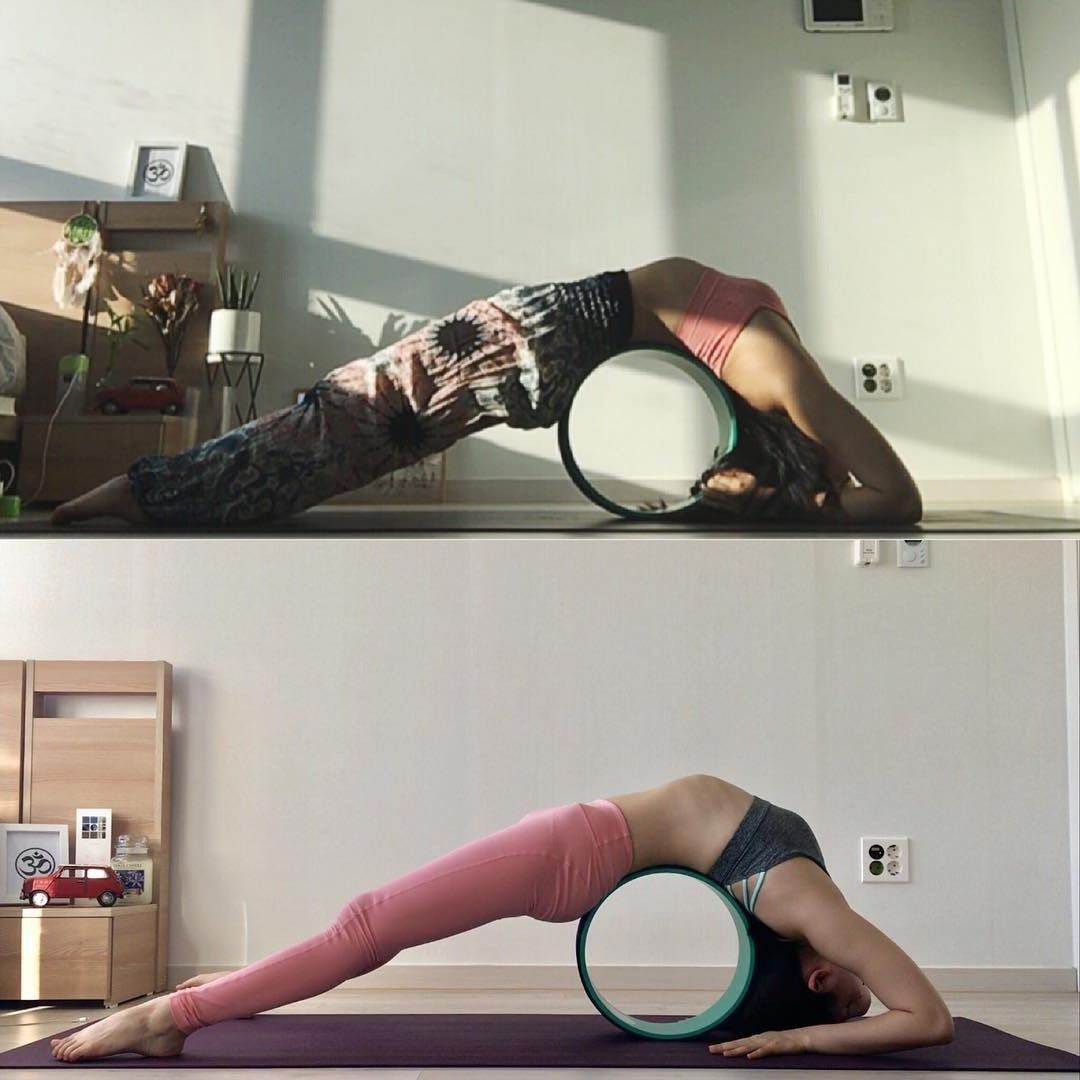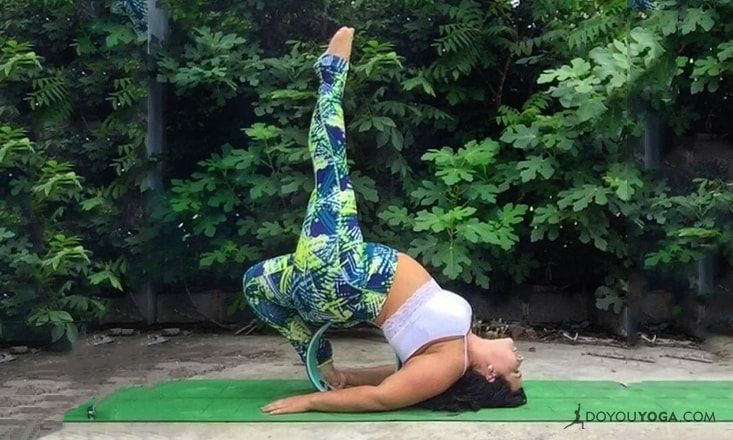A new-ish prop to the yoga scene, the yoga wheel can help elevate your yoga practice by supporting poses to further stretch and strengthen the body while releasing tension. Adding a fun spin to the practice, the yoga wheel can assist beginner to advanced yogis by allowing deeper access to postures and making even the most advanced poses approachable.
The prop is most often used to improve hip mobility, build core strength, and to ease yogis into deeper back and shoulder openers.
Try these go-to poses that incorporate the yoga wheel to progress your practice. Remember to warm up first with a few rounds of Sun Salutations before reaching into deeper expressions of the poses.
1. Deepen Backbends with Two-Legged Inverted Staff Pose (Dwi Pada Viparita Dandasana)

Using the wheel in backbends, the muscles of the spine are safely and comfortably able to stretch, release, and strengthen. Not only does this have a restorative effect on the back, shoulders, and chest, but the action of opening will progress other backbending postures (such as Wheel, Upward Dog, and Bow pose).
In addition to stretching the back of the body, you’ll benefit from this pose by opening the hips and abdomen as well.
Practice Tips: There are a few ways to approach backbends on the yoga wheel. Before attempting this peak pose, try rolling the spine on the wheel to gently open, massage, and prepare the back.
To incorporate the yoga wheel into the static posture of Two-Legged Inverted Staff Pose, first rest the thoracic spine on the prop right between the shoulder blades. Reach the arms up and then back dropping the head back gently resting the neck along the wheel. Grasp the yoga wheel behind your head and place the forearms on the ground.
From here, extend the legs out long and together. Keep expanding through the chest by drawing the shoulder blades away from one another and the elbows in to provide a deeper opening.
2. Core Strengthener & Handstand Prep with Plank

The yoga wheel is unique because it facilitates fluid movement during a yoga practice. This wheeling aspect of the nifty prop makes certain poses attainable and expedites the process of getting there.
Specifically, reaching deeper depths of core and arm strength is necessary for arm balances such as Handstand. As for the advanced yogi, the yoga wheel can prepare the body and mind for pressing into Handstand.
Practice Tips: From Plank position, start with the yoga wheel under the shins. Engage the core and pull the knees in towards the chest as the wheel rolls forward and under the tops of the feet. Extend back to Plank and repeat.
For the more advanced yogi working to progress their handstand pose, try keeping the legs straight without bending at the knees. From Plank pose, engage the core and legs as you pull the feet in towards the body. The toes become light on the wheel as the hips try to stack above the shoulders.
Taking advantage of the boost of the prop, try to lift the heels towards the sky into full Handstand pose.
3. Leg Flexibility with Splits (Hanumanasana)

Helping ease yogis into splits and improve mobility, the yoga wheel can be utilized to deepen hip and leg flexibility. Again, the rolling motion of the prop is handy as it simplifies and smoothes the sometimes jerky process of getting a split.
Practice tips: When entering Hanumanasana pose, place the yoga wheel under your front foot and roll the wheel forward until it’s under the calf and supporting the front leg. Lift the torso, lengthen through the spine, and sink the hips as much as possible but still within comfort.
4. Improve Balance with Crescent Lunge (Anjaneyasana)

The yoga wheel helps yogis tap into and strengthen stabilizer muscles that are key to stability and balance. Fine tuning the smaller underutilized muscles fortifies balancing poses and improves posture.
Try incorporating the yoga wheel when practicing Crescent Lunge to build balance, deepen hip flexibility, and strengthen the legs.
Practice Tips: From a standing position with one foot in front of the other, bring your back toes onto the yoga wheel. Start to glide the wheel back and bend the front knee to 90 degrees. Coming into full Crescent Lunge, straighten the back leg as the shin rests lightly on the prop.
The pose will be more challenging the closer in line the feet are, so for a more stable position bring the feet hip distance apart.
Whether practicing gentle restorative poses or practicing an intense power flow with challenging asana, the yoga wheel has its place. It can help you learn postures that wouldn’t normally be easily accessible by helping you get into, and efficiently master, yoga poses. Not only does it allow physical breakthroughs, but it can mentally and emotionally advance our practices and attitudes as well.
Image Credit: Brittany Richard


